coolant temperature Abarth Grande Punto 2007 Owner handbook (in English)
[x] Cancel search | Manufacturer: ABARTH, Model Year: 2007, Model line: Grande Punto, Model: Abarth Grande Punto 2007Pages: 207, PDF Size: 3.01 MB
Page 15 of 207
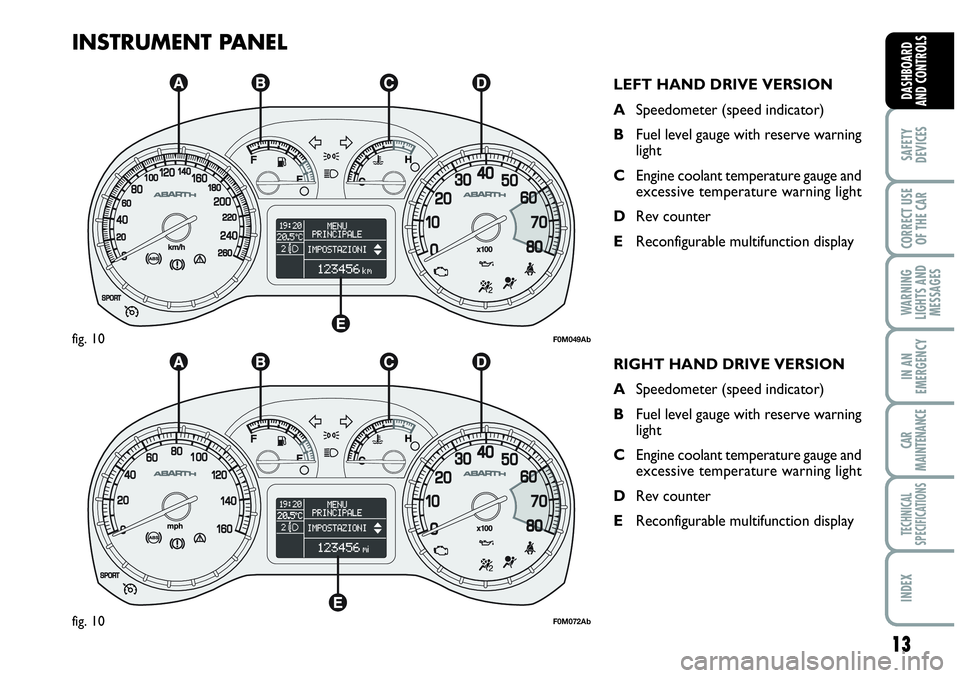
13
SAFETY
DEVICES
CORRECT USE
OF THE CAR
WARNING
LIGHTS AND
MESSAGES
IN AN
EMERGENCY
CAR
MAINTENANCE
TECHNICAL
SPECIFICATIONS
INDEX
DASHBOARD
AND CONTROLS
INSTRUMENT PANEL
LEFT HAND DRIVE VERSION
ASpeedometer (speed indicator)
BFuel level gauge with reserve warning
light
CEngine coolant temperature gauge and
excessive temperature warning light
DRev counter
EReconfigurable multifunction display
F0M049Abfig. 10
RIGHT HAND DRIVE VERSION
ASpeedometer (speed indicator)
BFuel level gauge with reserve warning
light
CEngine coolant temperature gauge and
excessive temperature warning light
DRev counter
EReconfigurable multifunction display
F0M072Abfig. 10
Page 17 of 207
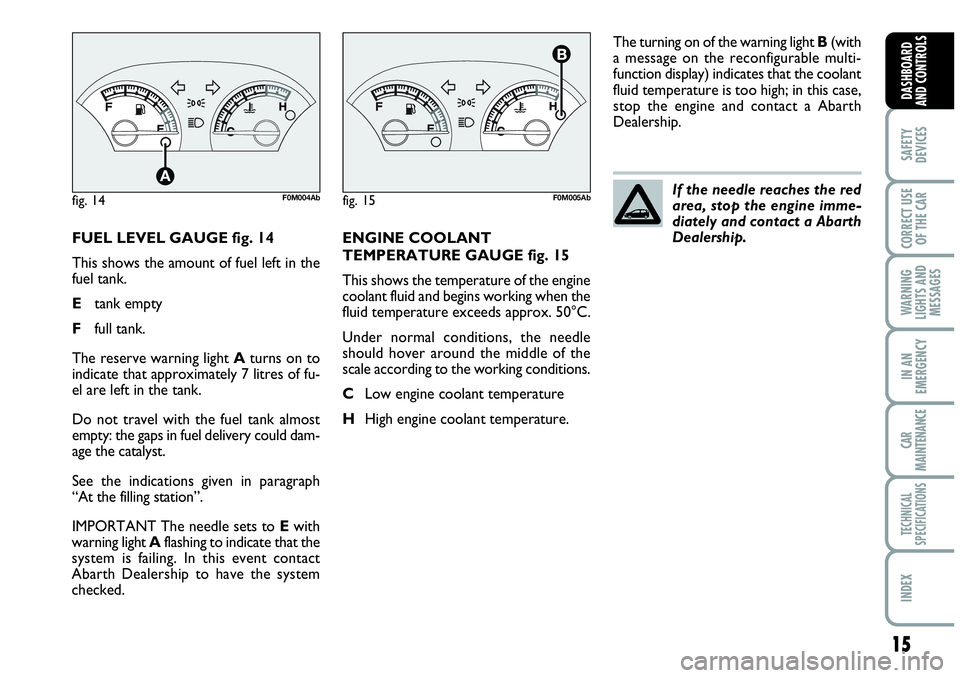
15
SAFETY
DEVICES
CORRECT USE
OF THE CAR
WARNING
LIGHTS AND
MESSAGES
IN AN
EMERGENCY
CAR
MAINTENANCE
TECHNICAL
SPECIFICATIONS
INDEX
DASHBOARD
AND CONTROLS
FUEL LEVEL GAUGE fig. 14
This shows the amount of fuel left in the
fuel tank.
Etank empty
Ffull tank.
The reserve warning light Aturns on to
indicate that approximately 7 litres of fu-
el are left in the tank.
Do not travel with the fuel tank almost
empty: the gaps in fuel delivery could dam-
age the catalyst.
See the indications given in paragraph
“At the filling station”.
IMPORTANT The needle sets to Ewith
warning light Aflashing to indicate that the
system is failing. In this event contact
Abarth Dealership to have the system
checked.ENGINE COOLANT
TEMPERATURE GAUGE fig. 15
This shows the temperature of the engine
coolant fluid and begins working when the
fluid temperature exceeds approx. 50°C.
Under normal conditions, the needle
should hover around the middle of the
scale according to the working conditions.
CLow engine coolant temperature
HHigh engine coolant temperature.The turning on of the warning light B(with
a message on the reconfigurable multi-
function display) indicates that the coolant
fluid temperature is too high; in this case,
stop the engine and contact a Abarth
Dealership.
If the needle reaches the red
area, stop the engine imme-
diately and contact a Abarth
Dealership.
fig. 14F0M004Abfig. 15F0M005Ab
Page 47 of 207

45
SAFETY
DEVICES
CORRECT USE
OF THE CAR
WARNING
LIGHTS AND
MESSAGES
IIN AN
EMERGENCY
CAR
MAINTENANCE
TECHNICAL
SPECIFICATIONS
INDEX
DASHBOARD
AND CONTROLS
Climate control compressor on/off
button B
Pressing button
√when the button led
is on, will deactivate compressor and turn
the button led off. Pressing the button
when the led is off will activate compres-
sor and turn the button led on. When
turning the compressor off, the system will
deactivate air recirculation to prevent win-
dow misting up.
In this event, although the system is able
to keep the required temperature, the
wording FULLwill disappear from the
display. If the system is no longer able to
keep the required temperature, temper-
ature value will flash and the wording
AUTOwill disappear from the display.
IMPORTANT With the climate control
compressor off, it is not possible to admit
air to the passenger compartment with a
temperature below the outside tempera-
ture; moreover, under certain environ-
mental conditions, windows could mist up
fastly since air is not dehumidified.
The switching off of the climate control
compressor remains in storage even when
the engine has been stopped.
To restore automatic control for switch-
ing on the climate control compressor,
press again button
√or press button AU-
TO.
With climate control compressor off if
outside temperature is higher than the set
one the system will not be able to keep
the required condition, the temperaturevalue will then start to flash on the display
for a few seconds and wording AUTO
will then go off.
With climate control compressor off, the
fan speed can be set to zero manually.
With compressor on and engine running,
the fan speed cannot be lower that one
bar on the display.
Fast window demisting/defrosting
button F
Press this button: the climate control sys-
tem will automatically switch on all the
functions required for fast windscreen and
front side window demisting/defrosting,
that is:
❒ switches on climate control compres-
sor when climatic conditions are suit-
able;
❒air recirculation off;
❒maximum air temperature HIon both
areas;
❒activates proper fan speed according to
engine coolant temperature to limit the
flow into the passenger compartment of
air not warm enough to demist the win-
dows;
❒ directs air flow to windscreen and front
side windows vents;
❒turns heated rear window on.IMPORTANT Fast demisting/defrosting
function stays on for about 3 minutes,
since engine coolant temperature reach-
es the proper temperature.
When the max. demisting/defrosting func-
tion is on, the button led and the heated
rear window button led are on.
FULL AUTOwording on the display is
off.
When the max. demisting/defrosting func-
tion is on, the only manual operations pos-
sible are manual adjustment of the fan
speed and switching heated rear window
off. Pressing the max. demisting/defrosting
button or the air recirculation buttons or
compressor off button or the AUTO
button, the system switches off the max.
demisting/defrosting function and restores
the operating conditions of the system pri-
or to turning it on.
Page 48 of 207

46
SAFETY
DEVICES
CORRECT USE
OF THE CAR
WARNING
LIGHTS AND
MESSAGES
IN AN
EMERGENCY
CAR
MAINTENANCE
TECHNICAL
SPECIFICATIONS
INDEX
DASHBOARD
AND CONTROLS
Heated rear window and door
mirror demisting/defrosting button
(for versions/markets,
where provided) G
Press this button to activate heated rear
window demisting/defrosting.
When this function is on, the button led
is on.
This function is timed and switches off au-
tomatically after about 20 minutes or by
pressing again the button or by turning the
engine off. It will not be switched on au-
tomatically when restarting the engine.
IMPORTANT Do not apply stickers on the
inside of the rear window over the heat-
ing filaments to avoid damage that might
cause it to stop working properly.
Switching the climate control
system off (OFF) E
Press button Eto turn the system off.
When turned off the system conditions
are the following:
❒set temperature displays off;
❒air recirculation is on;
❒conditioner compressor off;
❒fan off.
Heated rear window can be turned on or
off also when the system is off.
IMPORTANT The system will store the
temperatures set before turning off and
will resume them when pressing any but-
ton (except heated rear window); if the
function corresponding to the button
pressed is off it will be turned on; if on it
will be kept active.
Press AUTOto turn the system in au-
tomatic mode.ADDITIONAL HEATER
(for versions/markets,
where provided)
This device shall be used to speed up pas-
senger compartment warming when it is
very cold.
The additional heater turns off automati-
cally after reaching the required comfort
conditions.
Automatic two-zone climate
control system
The additional heater will switch on au-
tomatically after turning the ignition key
to ON.
Manual Heater and Climate
control system
The additional heater will switch on au-
tomatically by turning knob Ato the last
red sector and turning the fan on (knob
B) to the first speed at least.
IMPORTANT Heater works only with
low outside temperature and engine
coolant temperature.
IMPORTANT Heater will not turn on if
the battery voltage is not sufficient.
Page 113 of 207

111
WARNING
LIGHTS AND
MESSAGES
IN AN
EMERGENCY
CAR
MAINTENANCE
TECHNICAL
SPECIFICATIONS
INDEX
DASHBOARD
AND CONTROLS
SAFETY
DEVICES
CORRECT USE
OF THE CAR
STOPPING THE ENGINE
Turn the ignition to STOPwhile the en-
gine is idling.
IMPORTANT After a taxing drive, you
should allow the engine to “catch its
breath” before turning it off by letting it
idle to allow the temperature in the en-
gine compartment to fall.
A quick burst on the acceler-
ator before turning off the en-
gine serves absolutely no
practical purpose, it wastes
fuel and is damaging especially to tur-
bocharged engines.HOW TO WARM UP THE
ENGINE AFTER IT HAS JUST
STARTED
Proceed as follows:
❒ Drive off slowly, letting the engine turn
at medium revs. Do not accelerate
abruptly;
❒Do not drive at full performance for the
initial kilometres. Wait until the coolant
temperature gauge starts moving.
Remember that the servo-
brake and power steering are
not operational until the en-
gine has been started, there-
fore much effort than usual is required
on the brake pedal and steering wheel.
Never bump start the engine
by pushing, towing or coast-
ing downhill as this could
cause fuel to flow into the
catalytic exhaust system and damage
it beyond repair.
Page 123 of 207
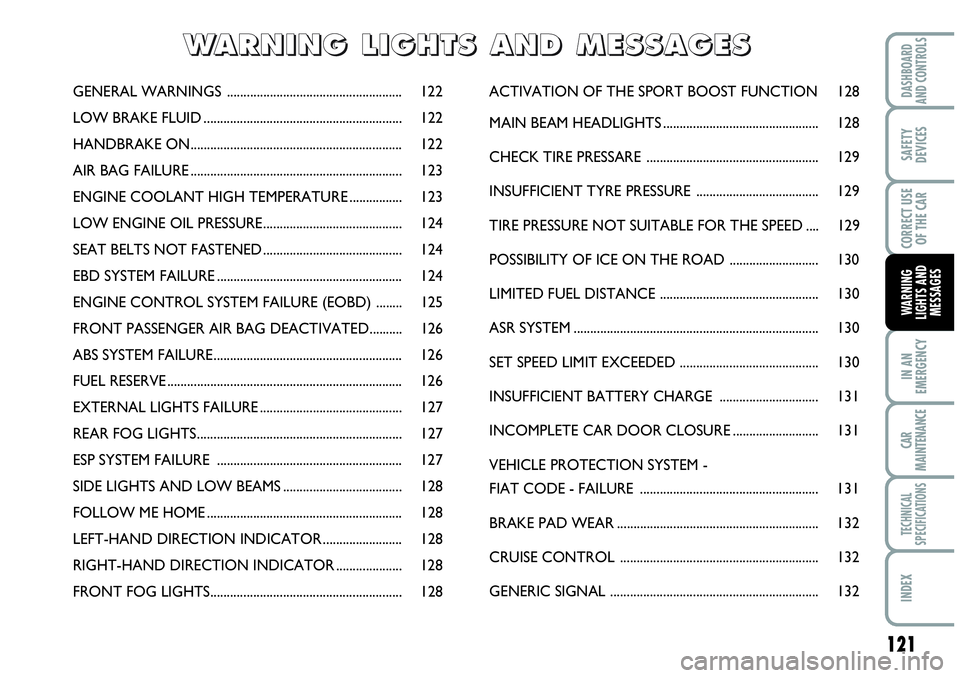
121
IN AN
EMERGENCY
CAR
MAINTENANCE
TECHNICAL
SPECIFICATIONS
INDEX
DASHBOARD
AND CONTROLS
SAFETY
DEVICES
CORRECT USE
OF THE CAR
WARNING
LIGHTS AND
MESSAGES
GENERAL WARNINGS ..................................................... 122
LOW BRAKE FLUID............................................................ 122
HANDBRAKE ON................................................................ 122
AIR BAG FAILURE ................................................................ 123
ENGINE COOLANT HIGH TEMPERATURE ................ 123
LOW ENGINE OIL PRESSURE.......................................... 124
SEAT BELTS NOT FASTENED .......................................... 124
EBD SYSTEM FAILURE ........................................................ 124
ENGINE CONTROL SYSTEM FAILURE (EOBD) ........ 125
FRONT PASSENGER AIR BAG DEACTIVATED.......... 126
ABS SYSTEM FAILURE......................................................... 126
FUEL RESERVE ....................................................................... 126
EXTERNAL LIGHTS FAILURE........................................... 127
REAR FOG LIGHTS.............................................................. 127
ESP SYSTEM FAILURE ........................................................ 127
SIDE LIGHTS AND LOW BEAMS.................................... 128
FOLLOW ME HOME ........................................................... 128
LEFT-HAND DIRECTION INDICATOR ........................ 128
RIGHT-HAND DIRECTION INDICATOR .................... 128
FRONT FOG LIGHTS.......................................................... 128ACTIVATION OF THE SPORT BOOST FUNCTION 128
MAIN BEAM HEADLIGHTS............................................... 128
CHECK TIRE PRESSARE .................................................... 129
INSUFFICIENT TYRE PRESSURE ..................................... 129
TIRE PRESSURE NOT SUITABLE FOR THE SPEED .... 129
POSSIBILITY OF ICE ON THE ROAD ........................... 130
LIMITED FUEL DISTANCE ................................................ 130
ASR SYSTEM.......................................................................... 130
SET SPEED LIMIT EXCEEDED .......................................... 130
INSUFFICIENT BATTERY CHARGE .............................. 131
INCOMPLETE CAR DOOR CLOSURE .......................... 131
VEHICLE PROTECTION SYSTEM -
FIAT CODE - FAILURE ...................................................... 131
BRAKE PAD WEAR ............................................................. 132
CRUISE CONTROL ............................................................ 132
GENERIC SIGNAL ............................................................... 132
W W
A A
R R
N N
I I
N N
G G
L L
I I
G G
H H
T T
S S
A A
N N
D D
M M
E E
S S
S S
A A
G G
E E
S S
Page 125 of 207

123
IN AN
EMERGENCY
CAR
MAINTENANCE
TECHNICAL
SPECIFICATIONS
INDEX
DASHBOARD
AND CONTROLS
SAFETY
DEVICES
CORRECT USE
OF THE CAR
WARNING
LIGHTS AND
MESSAGES
AIR BAG FAILURE (red)
Turning the ignition key in the
MARposition the warning
light turns on, it has to turn off
after a few seconds.
If the warning light does not turn off this
indicates a failure in the air bag system.
The display visualizes the specific message.
¬
If the ¬warning light does
not turn on while turning the
ignition key in the MAR position or
if it stays lighted while the car is in
motion there may be a failure in the
restraint systems; in this case the air
bags or the pretensioners may be de-
activated in the event of a collision
or, in a limited number of cases, ac-
tivate incorrectly. Before going on re-
fer to the Abarth Dealership in order
to have the system immediately in-
spected.
WARNING
The ¬warning light failure
(light off ) is signalled by the
flashing for over the normal 4 seconds
of the light “that signals that the
passenger-side air bag is deactivated.
WARNING
ENGINE COOLANT
HIGH TEMPERATURE
(red)
Turning the ignition key in the
MARposition the warning light turns on,
it has to turn off after a few seconds.
The light turns on when the engine is
overheated.
If the light turns on the following steps
must be followed:
❒if in normal driving conditions:
stop the vehicle, turn off the engine
and check that the water level in the
reservoir is not under the MINmark.
In this case wait a few minutes in or-
der to let the engine cool down, then
open slowly and very carefully the tap,
fill up with the coolant, making sure
that the coolant level is between the
MINand MAXmarks on the reser-
voir. Besides visually check the pres-
ence of possible leaks of coolant. If the
light turns on again after starting up
the engine refer to the Abarth Deal-
ership.
ç
❒in case of demanding use of the
vehicle(for example during uphill
hauling of trailers or when the vehi-
cle is fully loaded): slow down and, if
the light stays on, halt the car. Stop for
2 or 3 minutes keeping the engine on
and slightly revved up in order to
favour the active circulation of the
coolant, after that turn off the engine.
Check the level of the coolant in the
reservoir as previously described.
IMPORTANT In case of very exacting
routes it is advisable before turning off the
engine to keep it on and slightly revved up
for a few minutes.
The display visualizes the specific message.
Page 167 of 207
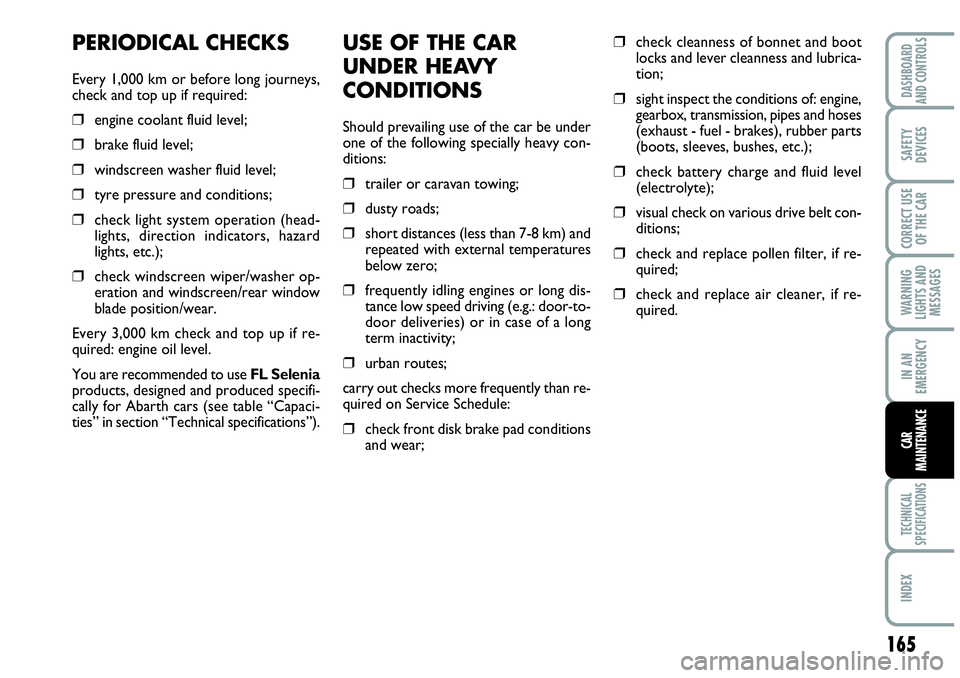
USE OF THE CAR
UNDER HEAVY
CONDITIONS
Should prevailing use of the car be under
one of the following specially heavy con-
ditions:
❒trailer or caravan towing;
❒dusty roads;
❒short distances (less than 7-8 km) and
repeated with external temperatures
below zero;
❒frequently idling engines or long dis-
tance low speed driving (e.g.: door-to-
door deliveries) or in case of a long
term inactivity;
❒urban routes;
carry out checks more frequently than re-
quired on Service Schedule:
❒check front disk brake pad conditions
and wear;
❒check cleanness of bonnet and boot
locks and lever cleanness and lubrica-
tion;
❒sight inspect the conditions of: engine,
gearbox, transmission, pipes and hoses
(exhaust - fuel - brakes), rubber parts
(boots, sleeves, bushes, etc.);
❒check battery charge and fluid level
(electrolyte);
❒visual check on various drive belt con-
ditions;
❒check and replace pollen filter, if re-
quired;
❒check and replace air cleaner, if re-
quired.
PERIODICAL CHECKS
Every 1,000 km or before long journeys,
check and top up if required:
❒engine coolant fluid level;
❒brake fluid level;
❒windscreen washer fluid level;
❒tyre pressure and conditions;
❒check light system operation (head-
lights, direction indicators, hazard
lights, etc.);
❒check windscreen wiper/washer op-
eration and windscreen/rear window
blade position/wear.
Every 3,000 km check and top up if re-
quired: engine oil level.
You are recommended to use FL Selenia
products, designed and produced specifi-
cally for Abarth cars (see table “Capaci-
ties” in section “Technical specifications”).
165
WARNING
LIGHTS AND
MESSAGES
TECHNICAL
SPECIFICATIONS
INDEX
DASHBOARD
AND CONTROLS
SAFETY
DEVICES
CORRECT USE
OF THE CAR
IN AN
EMERGENCY
CAR
MAINTENANCE
Page 170 of 207

168
WARNING
LIGHTS AND
MESSAGES
TECHNICAL
SPECIFICATIONS
INDEX
DASHBOARD
AND CONTROLS
SAFETY
DEVICES
CORRECT USE
OF THE CAR
IN AN
EMERGENCY
CAR
MAINTENANCE
WINDSCREEN/REAR WINDOW
WASHER FLUID fig. 4
To top up, remove the cap A.
Pour a mixture of water and TUTELA
PROFESSIONAL SC35, in the follow-
ing concentrations:
30% TUTELA PROFESSIONAL
SC35and 70% water in summer.
50% TUTELA PROFESSIONAL
SC35and 50% water in winter.
In case of temperatures below –20°C, use
undiluted TUTELA PROFESSIONAL
SC35fluid.
Check level through the reservoir. ENGINE COOLANT fig. 3
The coolant level shall be checked with
cold engine and shall be within the MIN
and MAXmarks on the tank.
If the level is low, pour slowly a mixture
of 50% distilled water and 50%
PARAFLU UP of the FL Selenia Group
through the filler neck Auntil the level
reaches MAX.
A 50-50 mixture of PARAFLU UPand
distilled water gives freeze protection to
–35°C.
For particularly hard climate conditions,
we recommend use of a 60%PARAFLU
UP and 40% demineralized water mix-
ture. The engine cooling system us-
es protective antifreeze fluid
PARAFLU UP. Use the same
fluid type as that already in
the cooling system when topping up.
PARAFLU UP fluid cannot be mixed
with any other type of fluid. Should it
happen, under no circumstances start
the engine; contact a Fiat Dealership.
The cooling system is pres-
surised. If necessary, replace
the cap only with another genuine
one, otherwise system efficiency
could be compromised. Do not re-
move the reservoir cap when the en-
gine is hot: you risk scalding yourself.
WARNING
fig. 3F0M0152mfig. 4F0M0154m
Page 200 of 207
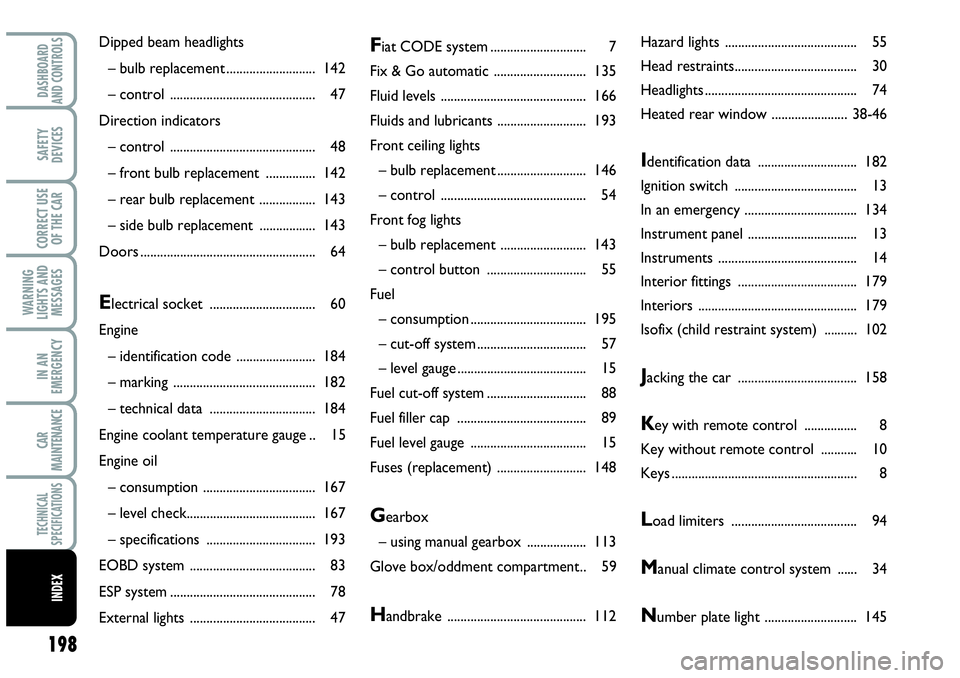
198
WARNING
LIGHTS AND
MESSAGES
DASHBOARD
AND CONTROLS
SAFETY
DEVICES
CORRECT USE
OF THE CAR
IN AN
EMERGENCY
CAR
MAINTENANCE
TECHNICAL
SPECIFICATIONS
INDEX
Fiat CODE system............................. 7
Fix & Go automatic ............................ 135
Fluid levels ............................................ 166
Fluids and lubricants ........................... 193
Front ceiling lights
– bulb replacement ........................... 146
– control ............................................ 54
Front fog lights
– bulb replacement .......................... 143
– control button .............................. 55
Fuel
– consumption................................... 195
– cut-off system................................. 57
– level gauge ....................................... 15
Fuel cut-off system.............................. 88
Fuel filler cap ....................................... 89
Fuel level gauge ................................... 15
Fuses (replacement) ........................... 148
Gearbox
– using manual gearbox .................. 113
Glove box/oddment compartment .. 59
Handbrake .......................................... 112Hazard lights ........................................ 55
Head restraints..................................... 30
Headlights.............................................. 74
Heated rear window .......................38-46
Identification data .............................. 182
Ignition switch ..................................... 13
In an emergency .................................. 134
Instrument panel ................................. 13
Instruments .......................................... 14
Interior fittings .................................... 179
Interiors ................................................ 179
Isofix (child restraint system) .......... 102
Jacking the car .................................... 158
Key with remote control ................ 8
Key without remote control ........... 10
Keys ........................................................ 8
Load limiters ...................................... 94
Manual climate control system ...... 34
Number plate light ............................ 145 Dipped beam headlights
– bulb replacement ........................... 142
– control ............................................ 47
Direction indicators
– control ............................................ 48
– front bulb replacement ............... 142
– rear bulb replacement ................. 143
– side bulb replacement ................. 143
Doors ..................................................... 64
Electrical socket ................................ 60
Engine
– identification code ........................ 184
– marking ........................................... 182
– technical data ................................ 184
Engine coolant temperature gauge .. 15
Engine oil
– consumption .................................. 167
– level check....................................... 167
– specifications ................................. 193
EOBD system ...................................... 83
ESP system............................................ 78
External lights ...................................... 47